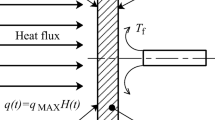Abstract
Unlike the transient response of a fluidimmersed thermocouple, and in contrast to common belief, the time response of a solid-embedded thermocouple is far from being similar to that of a first-order process. The current study arises from efforts to characterize the transient response of a solid-embedded thermocouple as a result of a step-like temperature change of the measured domain. Results of this study suggest that the response function of the thermocouple is nearly exponentially dependent on the square root of Fourier number (dimensionless time). It follows that, with respect to fluid temperature measurements, significantly faster time response is expected at the initiation of the process on one hand, and much longer time is required for reaching a steady-state temperature on the other hand. It is shown that the thermal diffusivity of the thermocouple is required to be at least one order of magnitude higher than that of the measured domain in order to obtain meaningful results in transient measurements.
Similar content being viewed by others
References
Rittel, D., “Transient Temperature Measurement Using Embedded Thermocouples,” EXPERIMENTAL MECHANICS,38, (2),73–78 (1998).
Benedict, R.P., Fundamentals of Temperature, Pressure, and Flow Measurements, Wiley-Interscience, New York (1984).
Holman, J.P., Experimental Methods for Engineers, 6th ed., McGraw-Hill, New York, (1994).
Omega Inc., The Temperature Handbook, Catalog Series,29,Stamford, CT (1996).
Miller, R.W., Flow Measurements Engineering Handbook, 3rd ed., McGraw-Hill, New York (1996).
Rabin, Y., “Uncertainty in Temperature Measurements During Cryosurgery,”Cryo-Lett,19 (4),213–224 (1998).
Rabin, Y., “Uncertainty in Measurements of Fluid Temperature in Tubes,”Cryo-Lett.,19, (5),319–326 (1998).
Holman, J.P., Heat Transfer, 6th ed., McGraw-Hill, New York (1986).
Zehnder, A.T. andRosakis, A.J., “On the Temperature Distribution at the Vicinity of Dynamically Propagating Cracks in 4340 Steel,”J. Mech. Phys. Solids,39,385–415 (1991).
Rabin, Y., Julian, T.B., andWolmark, N., “A Compact Cryosurgical Apparatus for Minimal-invasive Cryosurgery,”Biomed. Instr. Tech.,31,251–258 (1997).
Rabin, Y. andKorin, E., “An Efficient Numerical Solution for the Multidimensional Solidification (or Melting) Problem Using a Microcomputer,”Int. J. Heat Mass Trans. 36, (3),673–683 (1993).
Wally, K., “The Transient Response of Beaded Thermocouples Mounted on the Surface of a Solid,”ISA Trans.,17 (1),65–70 (1978).
Author information
Authors and Affiliations
Rights and permissions
About this article
Cite this article
Rabin, Y., Rittel, D. A model for the time response of solid-embedded thermocouples. Experimental Mechanics 39, 132–136 (1999). https://doi.org/10.1007/BF02331116
Received:
Revised:
Issue Date:
DOI: https://doi.org/10.1007/BF02331116




